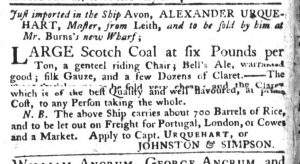GUEST CURATOR: Daniel McDermott
What was advertised in a colonial American newspaper 250 years ago today?

“Just imported … LARGE Scotch Coal.”
Since the eighteenth century, coal has been arguably one of the most important commodities in the history of industrialized civilizations. In eighteenth-century America, coal was imported from one of the many mines in Great Britain.[1] Commonly used as a source of energy, coal also brings environmental impacts to surrounding areas when it is burned.
According to the Environmental Protection Agency, its effects on the water cycle in the form of acid rain was one of the earliest known environmental effects from coal. Sulfur dioxide is released from the burning of coal and stays in the atmosphere. However, the sulfur is precipitated out of the atmosphere, just like water, but instead it becomes acid rain. The sulfur dioxide stays in the atmosphere for hundreds of years; therefore, the environmental effects from earlier periods are still present today.[2] For further information on how acid rain affects the environment, you visit the Environmental Protection Agency’s website.
John Evelyn first reported the effects of air pollution in seventeenth-century England by John Evelyn in his book, Fumufugium. According to Fredric C. Menz and Hans M. Seip, Robert Angus Smith “first conducted detailed studies of acid rain and described many of its potentially harmful effects” in 1872. The importation of coal in eighteenth-century America and the eventually rise of coal mining in North America eventually brought similar environmental problems across the Atlantic. The environmental impacts of coal are not confined to the boundaries of countries or continents.
**********
ADDITIONAL COMMENTARY: Carl Robert Keyes
Alexander Urquehart’s advertisement for “LARGE Scotch Coal at six Pounds per Ton” and an assortment of other goods appeared in an exceptional issue of the South-Carolina Gazette and Country Journal. Like the printers of newspapers in the largest port cities, Charles Crouch sometimes published a supplement when the amount of news, advertising, and other content exceeded what would fit in the standard four-page weekly issue. In most instances, supplements were printed on half sheets, limiting them to two pages. The Supplement to the South-Carolina Gazette and Country Journal issued on March 17, 1767, however, consisted of four pages – or an entire second broadsheet. The size of the sheet used for the supplement (with two columns of text) was not as large as that of the standard issue (with three columns), so this did not double the total content delivered to subscribers. Still, it significantly increased the size of that week’s issue.
In particular, it increased the amount of advertising delivered to readers of the South-Carolina Gazette and Country Journal. The entire supplement – all eight columns – was devoted exclusively to advertising. Indeed, paid notices of every variety practically eclipsed news items in the March 17 issue, making it a delivery mechanism for advertising rather than news (and presumably generating greater revenue for the printer than other issues that balanced the amount of space devoted to advertisements versus other content). Advertising comprised seven of the twelve columns in the standard issue in addition to filling the entire supplement.
Among the news items that did appear, the printer noted that “TO Morrow, being the Anniversary of the REPEAL OF THE STAMP-ACT, we hear will be observed by the Lovers of Liberty and America, with Hearts elate, for our happy Delivery from so manifestly intended Oppression.” Considering that the Stamp Act assessed taxes on each advertisement printed in colonial newspapers, in addition to those leveled for the newspaper itself, it seems appropriate that the printer of the South-Carolina Gazette and Country Journal would mark the first anniversary of its repeal by publishing an issue that overflowed with advertisements.
**********
[1] U.S. Department of Commerce, Historical Statistics of the United States: Colonial Times to 1970, Part 2 (Washington, DC: Government Printing Office, 1975), 1184.
[2] L.A. Barrie and R.M. Hoff, “The Oxidation Rate and Residence Time of Sulphur Dioxide in the Arctic Atmosphere,” Atmospheric Environment 18, no. 12 (1984): 2711-2722.
